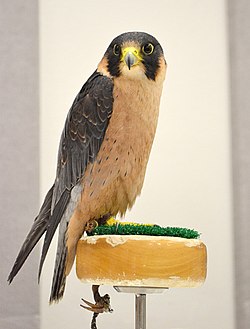Taita falcon
| Taita falcon | |
|---|---|
 |
|
| Taita falcon, photographed at the World Center for Birds of Prey, Boise, Idaho, USA. | |
| Scientific classification | |
| Kingdom: | Animalia |
| Phylum: | Chordata |
| Class: | Aves |
| Order: | Falconiformes |
| Family: | Falconidae |
| Genus: | Falco |
| Species: | F. fasciinucha |
| Binomial name | |
|
Falco fasciinucha Reichenow & Neumann, 1895 |
|
The Taita falcon (Falco fasciinucha) is a small falcon found in central and eastern Africa. It was first described from the Taita Hills of Kenya from which it derives its name.
This small falcon is fairly distinctive, but may offer some confusion with a few other species. The rufous belly causes resemblance with African hobby, but important features to look for are a white throat and the obvious rufous patches on the nape. Alsom the underwing coverts are uniform rufous, whereas the African hobby has more streaking. The most obvious underwing feature, though, is the flight feathers are barred black and white. whereas there is much more rufous color is in the flight feathers of the African hobby. The robust, long-winged Taita falcons have a short tail. Their flight is fast and somewhat heavy looking, but they are adept at aerial hunting.
The wingspan of males is 202–208 mm (8.0–8.2 in), and that of females is 229–240 mm (9.0–9.4 in). Males weigh 212–233 g (7.5–8.2 oz) and females 297–346 g (10.5–12.2 oz).
This species spends much of its time perched inconspicuously, emerging to pursue small birds with fast, parrot-like wingbeats. Occasionally, it soars high. Prey is captured on the wing and carried back to the perch to be eaten. It breeds April to September in East Africa and July to December in southern Africa. The nest is normally on bare rock, the clutch size is two to four eggs, incubation lasts 31–33 days, and the chicks fledge after about 42 days.
The Taita falcon is patchily distributed from eastern and southern Africa. Breeding has been recorded from southern Ethiopia, southeastern South Sudan, eastern Uganda, Kenya (may occur at low densities throughout the country), Tanzania (scattered records), eastern Zambia (a few sites), Malawi (two recent records), Zimbabwe (20–50 pairs), Mozambique (one record of unknown reliability), Botswana, and northeastern South Africa (one site). It breeds in highlands and mountain regions with high cliffs and river gorges, mainly in areas with low rainfall. It is a rare and poorly known species. With fewer than 50 known nest sites throughout Africa and with previously documented eyries abandoned,
Threats to the species come from the use of organochlorine pesticide sprays in northern Zimbabwe which may have reduced numbers there, and pesticide-spraying (e.g. through operations to control red-billed quelea and locusts) may pose a threat in other regions. Tourist flights using helicopters and microlight aircraft seem to have caused major disturbance to birds resident along the Victoria Falls gorges, where the remaining birds are threatened with flooding by a proposed dam. Reasons for its scarcity in East Africa possibly include competition for food and nest sites with the larger and more dominant peregrine falcon (Falco peregrinus) and predation of young by the peregrine falcon, lanner falcon (Falco biarmicus), and owls.
...
Wikipedia

